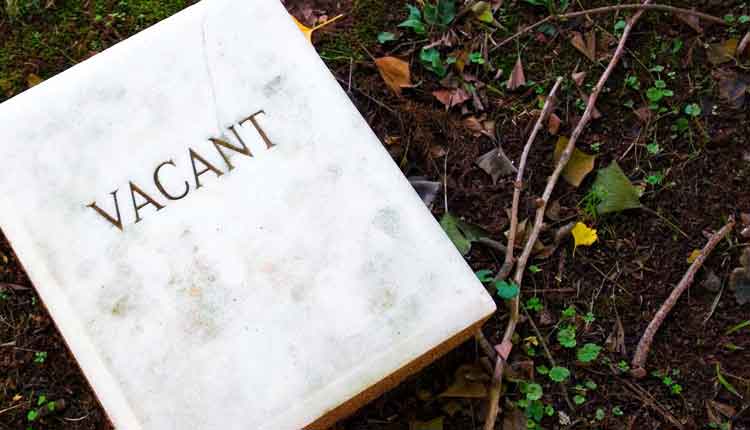A sermon on Luke 24:1-11.
On my smart phone I have a database that includes the name of everyone who has been a member here the whole time I have been here. When someone dies, I simply remove the code, “COM,” which stands for “Communicate Member,” and replace it with the code “PHS,” which means “Promoted into the Higher Service.”
On a day like today, when I seen so many of you who have come back, just for Easter, I not only see you, all of you, but I see all your connections, including those who have been “Promoted into the Higher Service.”
We have a wonderful hope, but it has not always been so, not even among the people of God.
The Hebrew Bible is not very hopeful about life after death. It uses the word heaven (and its derivatives) more than 400 times, but always a place where God lives. Heaven is the place where God hung the sun, and the moon, and stars without number. It is a place where birds fly, and from which rain falls. In the Old Testament we human beings live under heaven, but when we die, we do not go up into heaven, we go down into Sheol. Sheol is not a nice place.
- Sheol begins with the opening of any grave, including the most recent one, and its appetite and its boundaries extend beyond measure.
- Sheol is the place where it was impossible to remember and praise God. (Psalm 6:5)
- Sheol is the place where maggots form the bed beneath us, and worms the covering over us. (Isaiah 14:11)
- Sheol is the place where we return to the dust from which we are made. (Genesis 2:7, Genesis 3:19)
- Sheol has a huge appetite, and it is never satisfied. The more it eats, the more it wants. Sheol devours not just those who are old, ugly, sick, and impoverished; it devours those who are young and beautiful and full of the promise of life. It devours kings and queens, and great men and their families, and heroes and heroines. It was F. Scott Fitzgerald who said, “Show me a hero, and I will write you a tragedy.”
In Psalm 89:48 we read:
Who can live and never see death? (Or) Who can deliver his (or her) soul from the power of Sheol?
It is a retorical question. There was only one right answer: No one. Not one. Not even one. All of us live under the shadow and the power of death.
Jesus Christ recognized how little hope there was in the Hebrew Bible. In John 5:39, he said, “You search the scriptures, because in them you think you have eternal life, and they are they that testify of me.”
Did you get that? Jesus says that hope is there, in the Hebrew Bible, and that hope points to him, but he says that we have to search for it. I did search for it.
I found hope in the Law, but only with the help of Jesus. (Like his conversation with the Sadducees.)
I found hope in certain of the Psalms, but only because some of them are used in the New Testament as witness to the Resurrection of Jesus.
I found hope in Job 19:25-26 where in we read:
25 For I know that my Redeemer lives, and at last he will stand upon the earth; 26 and after my skin has been thus destroyed, then from my flesh I shall see God.
That sounds very hopeful, and one might reasonably ask, in the time before Jesus’s own resurrection how can one be so hopeful?
I suspect that the author of Job, and certain of the Psalmists, had a hope for life after death simply because they had a relationship with God, and they trusted him. They believed that same God who had been faithful to them in life, would be faithful to them in death. One 20th Century rabbi put it like this: “I believe in the resurrection, because it is easier for me to believe that God raises the dead, than it is to believe that God will forget me.”
I also found hope for eternal life in the Prophets of Israel. The prophets applied God’s faithfulness not just to certain individuals, but to the whole nation of Israel, to the whole people of God. Their faith is most visible in Ezekiel 37 wherein the prophet speaks of a vision in which God showed him a valley of dry bones, and commanded him to speak God’s word to those dry bones saying:
Behold, I will cause breath to enter you, and you shall live. 6 And I will lay sinews upon you, and will cause flesh to come upon you, and cover you with skin, and put breath in you, and you shall live; and you shall know that I am the LORD.”
By the time of Jesus, a great many Jews held the hope of the prophets, especially those who were associated with or influenced by the party of the Pharisees, like Saul of Tarsus. We know from the gospels, and from the Book of Acts, and from other contemporary sources what the Pharisees believed. They believed that, at the end of history, on the Last Day of this present age, the righteous dead who kept covenant with God and their neighbors, would be raised to Eternal Life in the heavenly kingdom. At the same time, sinners who failed to keep covenant with God and their neighbors, would be raised to Judgment, and to what some later called, “The Second Death.” There is a distinction between the first death and the second. Anyone with a knife, or a sword, or an ax, or a bottle of poison, or a tent peg, or a blunt instrument, or a gun, or a bomb, can deal out the first death. But God alone can dispense the second death, because their is no second death without a resurrection to life and judgment.
Of course, in the time of Jesus, there was still definitive no proof of the hope for life after death. The Sadducees were always happy to remind the Pharisees that the bodies of those who held the hope of resurrection still rested in their graves, residents of Sheol, waiting for a last Day that never seems to come.
Jesus himself challenged the Sadducees. First he challenged them from scripture. In Matthew 22:32 he said to them, “As for the resurrection of the dead, have you not read what was said to you by God, ‘I am the God of Abraham, and Isaac, and Jacob.’ He is not God of the dead, but of the living.”
Then he challenged them in his own death and resurrection. According to St. Luke, it happened like this.
St. Luke says that Jesus died an innocent man. In Luke 23:4, we read that at the trial of Jesus, Pilate, the very man who condemned him to death said, “I find no crime in this man.” There was a crime, but it was ours, not his. St. Luke says that he was delivered into the hands of sinful men. St. Paul says, “He died for our sins, in accordance with the scriptures.”(1st Corinthians 15)
After the crucifixion and death of Jesus, Joseph of Arimathea, a good man, who was a dissenting member of the same Jewish council that condemned Jesus and handed him over to Pilate, went to the governor and asked for the body of Jesus. Then he wrapped the body in a linen shroud, and laid it in a new tomb, where no one had ever yet been laid. That tomb was nothing special. It was located in a garden, but it had no particular beauty, and no special powers. It is famous, later, and only because people said of it, “Jesus the Messiah once slept here!”
Of course, I am getting ahead of the story. Luke says that Joseph buried Jesus a Friday, on the day of preparation.
Saturday was the Passover, and the Sabbath, and all the characters in our story rested. While they rested, the tomb was silent, and the body of Jesus rested therein. Only God really knows what Jesus himself experienced during that Great Sabbath Rest. The Apostles Creed declares, “He went to the place of departed spirits,” or, sometimes, “He descended into hell.” In 1st Peter 3:19 we read that Jesus went and preached to the spirits in prison, who formerly did not obey. We repeat that same line in our Easter Morning Liturgy. We dare not make too much of it. It is best to say only that the same Jesus who was active for our salvation in life, and in the act of dying, was still active for our salvation in his death.
Then, early, on the morning of the third day, which was the first day of the week, a number of women, including Mary Magdalene, who had watched Joseph place the body of Jesus in the tomb on Friday, came back to the tomb to say a final goodbye to him. They went to the tomb to anoint him with spices, according to the burial custom of the Jews. It never happened. When the women arrived at the tomb, they had the stone rolled away, and when they entered the tomb they found it empty. The body of Jesus was gone. Suddenly, two men were there with them, and they were dressed in dazzling apparel. The women fell at their feet. In retrospect, the women, and all who heard their story supposed those men to be angels. They asked the women a question that must have stirred them deep in their souls. They asked, “Why do you look for the living among the dead?” And then they reminded the women of how, when Jesus was still in Galilee, he had told his disciples that “..the Son of man must be delivered into the hands of sinful men, and be crucified, and on the third day rise.” (Luke 24:7) And the text says that the women, “remembering his words,” that is, the words of Jesus, rushed to the house where the eleven had gathered with other followers of Jesus, and told them their story of an empty tomb, and how two mysterious strangers had reminded them that Jesus himself had predicted he would rise again. According to the text, the apostles and all the rest regarded the story of the women as an idle tale, and they did not believe them. (Luke 24:11)
We know from the Gospel of Luke (Luke 24:24), and from the Gospel of John (John 20:1-10) that the disciples of Jesus explored the empty tomb, but with one possible exception, the beloved disciple, as this is by no means certain, the empty tomb did not convince the disciples that Jesus was alive.
This should not surprise us. After all the apostles were descended from a people who lived among the Egyptians for 400 years, and though the Egyptians believed devoutly in life after death, making it a national pastime, the Hebrew Children never adopted their belief, not even after they saw the power of God at work for them during the Exodus.
Besides, there were too many possibilities with regard to an empty tomb. Over the years different people suggested that:
- The tomb could have been empty because the women went to the wrong tomb. Over the centuries Many skeptics have suggested this.
- The tomb could have been empty because some callous person had taken the body of Jesus away, and laid it in a cheaper grave, or and tossed it into the local trash heap. (John 20:2)
- The tomb could have been empty, because some disciples of Jesus remembered how he said he would rise from the dead, and they took the body, and hid it, because they wanted to fool the people into thinking he was alive. (Matthew 27:62-64) The only trouble is, no one every figured out how such a hoax could profit anyone.
The Empty Tomb did not produce the Easter Faith of the apostles. They did not believe in the Resurrection of Jesus, until they came face to face with the Risen Christ. St. Luke says that Jesus revealed himself to his disciples in the following ways:
First, Jesus appeared to two disciples on the Road to Emmaus. At first they did not recognize him, even though he instructed them in what the scriptures had to say about how the Christ had to suffer many things and enter into his glory. As they drew near their destination, the stranger appeared to be going farther, but they compelled him to take supper with them. At supper, he took bread, and blessed it, and broke it, and the text says that he was known to them in the breaking of the bread. Then he disappeared. This passage is dear to me, as I am never more certain in my faith than during a service of Holy Communion.
After this, the two disciples returned immediately to Jerusalem where they found their brothers, and must have said, “The Lord is Risen,” because the disciples responded, “The Lord is risen indeed, and has appeared to Simon.” Luke does not furnish us details about that particular reunion, but St. Paul regards the appearance of Jesus to Peter as supremely important, and he lists Simon Peter first among those to whom Christ appeared. (1st Corinthians 15:3-11)
Finally, while all the disciples in that place were still discussing what had taken place, Jesus himself appeared among them. They were startled and frightened, and supposed that they saw a spirit. And then Jesus presented himself to all of them, and asked, “Why are your troubled, and why do questions arise in your heart?” Then because they were troubled, and filled with questions, he invited them to examine his hands and his feet, no doubt still showing the marks where the Roman soldiers had driven the cruel spikes that fixed him to the cross, and to handle him, and see that he was not a spirit, but flesh and bones. And while they still disbelieved and wondered, Jesus moved them back into the realm of the everyday and he said to them, “Have you anything here to eat?” And they gave him a piece of broiled fish, and he took it and ate it before them.
I love how Jesus reveals himself at first rather dramatically, “he appears among them,” yet in such simple fashion, “Have you anything here to eat?”
The empty tomb did not create faith in the resurrection of Jesus, but it does tell us something about the nature of the resurrection. There is a continuity between the Jesus who died, and the Jesus who was raised. He is the same, only more so. In this regard, St. Luke believes exactly as does St. Paul. In 1st Corinthians 15, he talks about the difference between our bodies before death, and our bodies after death. It is obvious that he is thinking about the Death and Resurrection of Jesus when he writes:
42 What is sown is perishable, what is raised is imperishable. 43 It is sown in dishonor, it is raised in glory. It is sown in weakness, it is raised in power. 44 It is sown a physical body, it is raised a spiritual body.
The Empty Tomb does not produce faith, but it does shape the faith that is produced in us by a living Christ. It stands as the massive sign that God has not abandoned us in our little world of time and space, but, in the person of his son, Jesus the Messiah, he has entered it, shattered it, and begun its transformation. Because he lives, we, and those whom we love, will live also. The story that the women brought to the apostles was not “an idle tale,” nor was it definitive proof of the resurrection, but it does reveal the character of the resurrection for all of us.
Of course, some people are not nearly as concerned with life after death, as they are with life after birth. They want to know if God cares for them right now. He does.
When I was in seminary, I had a course on the resurrection of Jesus. At the completion of that course, I called my dad, also a pastor, and said, “Dad, we ought to present the proof of the resurrection.” He said, “No, we ought to preach the risen Christ with power to save.” It is true! The same Power that took Jesus out of the grave is available to us today, not just in the moment of our death, but in the midst of life. He saves us from sin, and death, and hopelessness in all its forms. He is God’s promise that God cares deeply about you. He is the Risen Lord who rules over all, and invites you into lasting fellowship with Himself.
Finis
Worth Green, Th.M., D.Min.







